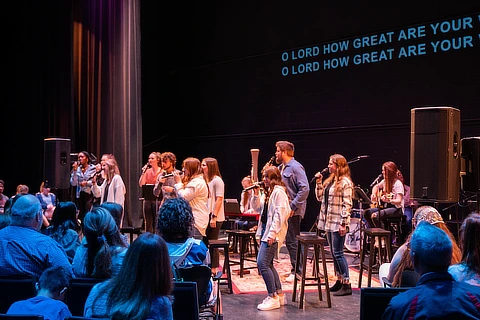
One of the great distinctives of the Christian faith is its emphasis on singing as a primary method for expressing worship to God. The word “sing” appears in the Bible over 400 times and at least 50 of those are commands. Familiar passages include:
- “Oh, sing to the Lord a new song; sing to the Lord, all the earth!” (Psalm 96:1)
- “…but be filled with the Spirit, addressing one another in psalms and hymns and spiritual songs, singing and making melody to the Lord with your heart…” (Eph. 5:18b-19)
To be clear: the word “worship” does not equal singing or music, as is often implied in statements like “I love our church because of the worship and the preaching.” But at a minimum, worship includes music and, specifically, singing. Over the centuries as believers have assembled to offer a united expression of worship, one of the most important resources for promoting a corporate sound of praise has been vocal music.
The people of God are known for singing their faith. While this may seem like an obvious statement, what is not always obvious for us as leaders is how we are to help congregations sing their faith. Many churches acknowledge that congregational singing is important, but their approach in corporate worship often discourages singing. I’ve frequently said that you can tell a lot about the health of a church based on the quality of its congregational singing.
To encourage vibrant/robust congregational singing, songs should be:
- well-written
- well-chosen
- well-led
For a song to be well-written means that it doesn’t include musical or lyrical hurdles for the congregation to jump over in order to sing. For example, we often rob the congregation of their voice by using songs that are “performative” or “soloistic.” Congregational songs should be musically accessible for large groups and in singable keys with a vocal range that fit the average, untrained voice. Typically, that means the range of the melody is between an octave and a 12th with the lowest and highest notes landing around A3/D4 for males and A4-D5 for females. Other diagnostic questions include: can the songs be sung by the youngest and the oldest worshiper? Is the language understandable and does it use good grammar? Read the lyrics out loud without the music. Do they flow naturally in the voice and make sense?
To further enhance and encourage congregational singing, songs must be chosen and scheduled with discernment and intentionality. It’s all about timing, and the right song at the wrong moment is the wrong song. Unfortunately, many worship leaders choose songs for worship on “shuffle.” The metric for including a song in worship must be more than “I love this song” or “Everyone is doing it.” Be intentionally selective with songs for worship and think carefully about what happens before and after a song to see if it enhances or detracts from the forward movement or “arc” of the service.
Lastly, for vibrant congregational singing to take place, the songs in worship must be well-led. Healthy worship leadership views the congregation as a member of the worship team, not the “audience.” This means that the manner of leadership from the platform brings the voice of the congregation forward as opposed to stifling it. Remember: the mark of effective worship leadership is not how well the worship leaders sound but how well the congregation sounds. We want to do things that encourage singing and not do those things that discourage singing. Here are some common practices that often distract congregations and discourage their singing:
- Excessive vocal ad lib moments (common in more recent worship music). This confuses the congregation and they are not sure whether they should sing.
- Bright stages and dark rooms create the feeling of a “concert” where people assume their role is to watch and listen rather than participate.
- On screen, the lyrics are often too small, formatted poorly, include typos, are mis-timed or have excessive movement in the background.
- Poor audio quality where the audio mix is unclear, too loud, or too soft.
These types of issues contribute to a distracted state of mind that hinders fully engaged singing. Let’s be diligent and vigilant to promote and protect the congregation’s voice as they lift their offering of worship to God.
Questions for reflection:
- In your context, what are the primary factors that determine how you select songs for a worship service?
- Do an inventory of the songs in your services over the last 3 months. How often do the songs use individual (“I/me”) vs. corporate (“us/we”) language?
- What musical distractions (poor quality of singing or playing, keys are too high or low, songs are too “soloistic”, etc.) might be present in the songs that are discouraging people from singing?
- What technical distractions (i.e., audio, video, lighting) might be present in your services that are discouraging people from singing?
